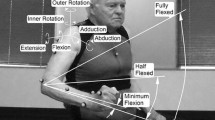Abstract
Single-joint elbow flexions are associated with muscle activity at the shoulder that opposes interaction torques arising from rotation of the elbow. We have previously shown that this activity is linearly related to elbow muscle torque and is robust in the presence of novel dynamic loads. Here we examined this relationship in the context of shoulder joint fixation. We tested the hypothesis that after mechanically fixing the shoulder the relationship between shoulder muscle activity and elbow muscle torque will be preserved. In contrast, proposals in which energetic variables are optimized predict that shoulder muscle activity should cease. Subjects performed single-joint elbow flexions in a horizontal plane while interacting with the KINARM robotic exoskeleton. After repeated movements with the shoulder joint fixed we observed a slight and gradual decrease in the activity of pectoralis major relative to movements in which the shoulder was free to rotate. However the strength of the coupling between the shoulder and elbow did not change after shoulder fixation. This is consistent with our previous findings and suggests that the nervous system maintains this inter-joint coupling relationship even when activity at the fixed joint is no longer needed for movement accuracy.


Similar content being viewed by others
References
Almeida GL, Hong DA, Corcos D, Gottlieb GL (1995) Organizing principles for voluntary movement: extending single-joint rules. J Neurophysiol 74:1374–1381
Debicki DB, Gribble PL (2004) Inter-joint coupling strategy during adaptation to novel viscous loads in human arm movement. J Neurophysiol 92:754–765
Galloway JC, Koshland GF (2002) General coordination of shoulder, elbow and wrist dynamics during multijoint arm movements. Exp Brain Res 142:163–180
Gribble PL, Ostry DJ (1999) Compensation for interaction torques during single- and multijoint limb movement. J Neurophysiol 82:2310–2326
Gribble PL, Scott SH (2002) Overlap of internal models in motor cortex for mechanical loads during reaching. Nature 417:938–941
Hollerbach MJ, Flash T (1982) Dynamic interactions between limb segments during planar arm movement. Biol Cybern 44:67–77
Kawato M, Maeda Y, Uno Y, Suzuki R (1990) Trajectory formation of arm movement by cascade neural network model based on minimum torque-change criterion. Biol Cybern 62:275–288
Koshland GF, Galloway JC, Nevoret-Bell CJ (2000) Control of the wrist in three-joint arm movements to multiple directions in the horizontal plane. J Neurophysiol 83:3188–3195
Latash ML, Aruin AS, Shapiro MB (1995) The relation between posture and movement: a study of a simple synergy in a two-joint task. Hum Mov Sci 14:79–107
Nakano E, Imamizu H, Osu R, Uno Y, Gomi H, Yoshioka T, Kawato M (1999) Quantitative examinations of internal representations for arm trajectory planning: minimum commanded torque change model. J Neurophysiol 81:2140–2155
Sainburg RL, Ghilardi MF, Poizner H, Ghez C (1995) Control of limb dynamics in normal subjects and patients without proprioception. J Neurophysiol 73:820–835
Scheidt RA, Reinkensmeyer DJ, Conditt MA, Rymer WZ, Mussa-Ivaldi FA (2000) Persistence of motor adaptation during constrained, multi-joint, arm movements. J Neurophysiol 84:853–862
Scott SH (1999) Apparatus for measuring and perturbing shoulder and elbow joint positions and torques during reaching. J Neurosci Methods 89:119–127
Shadmehr R, Mussa-Ivaldi FA (1994) Adaptive representation of dynamics during learning of a motor task. J Neurosci 14:3208–3224
Uno Y, Kawato M, Suzuki R (1989) Formation and control of optimal trajectory in human multijoint arm movement. Minimum torque-change model. Biol Cybern 61:89–101
Wada Y, Kaneko Y, Nakano E, Osu R, Kawato M (2001) Quantitative examinations for multi joint arm trajectory planning—using a robust calculation algorithm of the minimum commanded torque change trajectory. Neural Netw 14:381–393
Acknowledgements
This research was funded by grants from NSERC and CIHR (Canada).
Author information
Authors and Affiliations
Corresponding author
Rights and permissions
About this article
Cite this article
Debicki, D.B., Gribble, P.L. Persistence of inter-joint coupling during single-joint elbow flexions after shoulder fixation. Exp Brain Res 163, 252–257 (2005). https://doi.org/10.1007/s00221-005-2229-6
Received:
Accepted:
Published:
Issue Date:
DOI: https://doi.org/10.1007/s00221-005-2229-6




